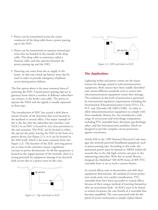 Website:
BOURNS
Website:
BOURNS
Catalog excerpts

The Design Challenge: The continued development of new broadband services such as video and interactive programming is causing an ever-increasing demand for wider band- width. This quest for bandwidth has been responsible for the telecommunications industryΒs major step from copper based cabling to fiber optics. As fiber optics integrate themselves into most cable networks, they have now taken on a hybrid fiber/coax (HFC) style of architecture. HFC architecture has now become the leading choice of both Cable TV (CATV) companies and telephone service providers. Because of the similar- ity of the HFC architecture to their existing networks, cable companies in particular are embracing HFC as an affordable way to position themselves as telephony vendors in a competitive, multi- service future. CATV systems have a vision of providing a complete networked home package where video on demand (VOD), high speed internet and telephony will all be provided via one system: the HFC network. HFC Architecture: HFC architecture usually consists of a fiber trunk line carrying signals in the form of video or telephony from the headend or central office (CO), to feeder cables serving local neighborhoods. Optical nodes on the trunk line convert the signals from light in the fiber optics to radio frequencies (RF) for the copper cables. The feeder cable, a medium sized coaxial cable, provides the signals from the trunk cable to entire neighborhoods. Individual houses subscribing to the cable services have drop lines connected to the feeder cables via taps and network interface devices (NIDs) attached to the outside of their homes for cable telephony and set top boxes for video. Figure 1 below gives a basic layout of how an HFC network should look. > R1220T705 R1220T505 NIDDrop R1220T505 Node HeadendorCOFeeder Coax CableFiber TrunkCable Tap Figure 1. Hybrid fiber / coax (HFC) architecture Cable Telephony: Unlike cable TV where power to operate the TV is not transmitted along the cables, cable telephony requires applications power to operate the NIDs. In a cable telephony system, the cable transmits the signal information and in many cases the local operating power for the NIDs, in 60V to 90V form. Powering the local NID can be carried out in any of the following ways: >
Open the catalog to page 1
Power can be transmitted across the center conductor of the drop cable from a power passing tap to the NID.ՕPower can be transmitted on separate twisted pair wires that are bonded to the outside of the drop cable. This drop cable is sometimes called a Siamese cable, and also operates between the power passing tap and the NID.Powering can come from the ac supply in the home. In this case a back-up battery must also be used in order to provide emergency telephone access during power failures.The first option above is the most common form ofpoweringthe NID. Coaxial power passing taps act as...
Open the catalog to page 2
Ю Asia-Pacific: TEL +886- (0)2 25624117FAX +886- (0)2 25624116 Europe: TEL +41-41 7685555FAX +41-41 7685510 North America: TEL +1-909 781-5500FAX +1-909 781-5700 bourns.com > COPYRIGHT Ω 2002, BOURNS, INC. LITHO IN U.S.A. 01/02 MF0182 rev size="-1">
Open the catalog to page 3All BOURNS catalogs and technical brochures
-
SM91501ALO BMS Transformer
4 Pages
-
SM91502ALA BMS Transformer
4 Pages
-
1.5SMBJ TVS Diode Series
6 Pages
-
CG0402MLU/ CG0603MLU
3 Pages
-
CG0402MLE/ CG0603MLE
3 Pages
-
CG0402MLD/ CG0603MLD
3 Pages
-
CG0402MLC/ CG0603MLC
3 Pages
-
CG0402MLA/ CG0603MLA
4 Pages
-
CG0603
1 Pages
-
CG0201MLA
1 Pages
-
CGA0603MLC
1 Pages
-
CGA0402MLC
1 Pages
-
CGA1206MLA
2 Pages
-
CGA0805MLA
2 Pages
-
CGA0603MLA
2 Pages
-
Automotive Product Profile
12 Pages
-
Industrial Panel Controls
8 Pages
-
Sensors and Controls
73 Pages
-
Bourns® Outside Plant Products
16 Pages
-
Spotlight I
2 Pages
-
Circuit Protection Selection Guide
108 Pages
-
Trimpot® Product
172 Pages
-
EMS22
8 Pages
-
EM14
8 Pages
-
Pro Audio
12 Pages
-
Rotary Encoders
8 Pages
-
Resistor Networks
10 Pages
-
Gas Discharge Tubes
16 Pages
-
Fixed Resistors & Arrays
8 Pages
-
Bourns Power Resistors
6 Pages
-
Bourns RF Power Resistors
6 Pages
-
ChipGuard®
6 Pages
-
Chip Resistors & Arrays
8 Pages
-
Diode
16 Pages
-
Bourns Product Profile
36 Pages
-
Magnetic Encoders EMS22A
4 Pages
-
Contacting Encoders 3315
5 Pages
Archived catalogs
-
Trimpot® Product Catalog
172 Pages
-
J.W. Miller Magnetics Catalog
204 Pages
-
Inductive Component Solutions Guide
212 Pages
-
Circuit Protection Selection Guide
108 Pages
-
The Potentiometer Handbook
227 Pages
-
Bourns® Product Profile Brochure
30 Pages



































































